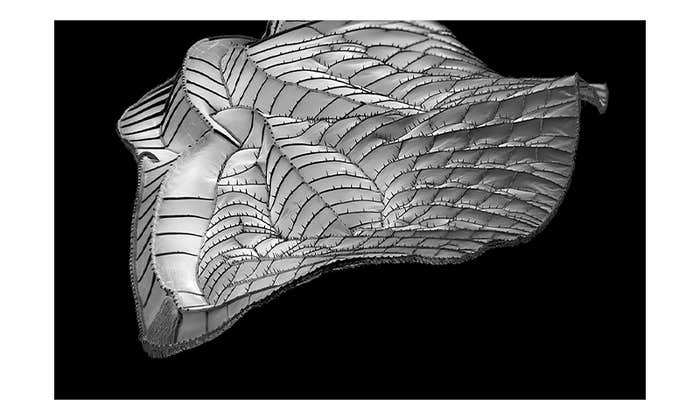
Language,” the Beat writer William S. Burroughs supposedly once exclaimed, “is a virus from outer space.” Burroughs was making a metaphorical extrapolation about the ways in which words, phrases, idioms, sentences, lines, and narratives can seemingly rewire our brains; how literature has the power to reprogram a mind just as a virus can alter the DNA of its host. Such a concept holds that more than just a simple means of expressing and communicating ideas, language is its own potent agent, a force that actually has the ability to shape the world, often in ways that we’re unconscious of and with an almost autonomous sense of itself.
As with something biological, language is capable of infecting, of propagating and spreading, of indelibly marking its host. In Burroughs’ characteristically experimental 1962 novel The Ticket that Exploded, he writes that “Word is an organism… a parasitic organism that invades and damages.” His concept of the viral nature of language has, appropriately enough, mutated and multiplied across culture, influencing figures from the musician and performance artist Laurie Anderson who composed a piece whose title comes from the Burroughs’ quotation, to the biologist Richard Dawkins’ concept of “memes.” In 1970’s The Electronic Revolution, Burroughs writes that “I have frequently spoken of word and image as viruses or as acting as viruses, and this is not an allegorical comparison.”
Xenotext is coded to alter its composition based on the relationship between DNA and RNA.
For Canadian poet Christian Bök the contention that language is a virus is very much not allegorical, or rather it’d be more correct to say that for him, poetry can be a bacterium. By the 2011 announcement of his Xenotext experiment, Bök was already famous (or infamous) for poems like 1994’s Crystallography, which he described as a “pataphysical encyclopedia that misreads the language of poetics through the conceits of geology,” and his Griffin Poetry Prize winning Eunoia in which each of the five chapters is written so that only one type of vowel is used in each one. Xenotext was far more provocative (and controversial) than any of Bök’s past poems, for with the assistance of a laboratory at the University of Calgary he proposed to encode into the genetics of a bacterium named Deinococcus radiodurans the very words of his poem. Bök proposed that the letters which composed a conventional sonnet could be translated into, as Dianne Timblin explains in American Scientist, “each of the 26 codons (the nucleotide triplets that form the basic units of genetic code,” which are then artificially inserted into the bacterium’s DNA, so that in a literal way the word could become flesh.
First experimenting on the easier to use (but far less durable) E.coli bacterium, the Xenotext project has been a multiyear experiment whose first volume (which included scientific data and poetry about the project itself) only saw publication in 2015, at a cost so far of $110,000 (for which critics, both poetic and scientific, might question if this is the best use of resources). Timblin provides a helpful primer on how exactly Bök’s poem is to be produced, explaining that the DNA “enciphered with a poem” is inserted into Deinococcus radiodurans, so that the “cell responds by transcribing the inserted DNA into RNA” and that the “RNA may then be read using a substitution cipher” devised by the poet. This “unreciphered RNA sequence creates a second sonnet seen as responding to the first.” Appropriately enough, the response sonnets in Bök’s cycle are titled “Orpheus” and “Eurydice” after the Greek mythological poet who descended to Hades to resurrect his wife, with the former written in DNA and the later then generated by the resultant RNA.
The poet explained that when his sonnet is “translated into a gene and then integrated into a cell… [it will] cause the organism to manufacture a viable, benign protein in response—a protein that, according to my original, chemical alphabet, is itself yet another text.” Thus, Bök imagined that gene X-P13 as altered in the Deinococcus radiodurans would be “a life-form so that it becomes not only a durable archive for storing a poem, but also an operant machine for writing a poem.” Where an individual poet might edit, revise, and rewrite their lyrics, and where an oral tradition might naturally change over the course of its transmission, Xenotext is coded to alter its composition based on the relationship between DNA and RNA, between Orpheus and Eurydice. Bök begins “Orpheus” with “Any style of life/is prim,” an opening appropriately congruent with the nature of the Xenotext, and “Eurydice” responds in a sonnet of protein, its first line reading “The faery is rosy/of glow.”
By writing verse through genetic engineering, Bök’s Xenotext promised to make Burroughs’ contention about language’s viral nature explicit, not allegorical. As language propagates, infects, and alters the minds which it encounters, so too does the ever reproducing Deinococcus radiodurans promise to replicate Bök’s verse to a greater extent than a mere printing press ever could. Xenotext in part speaks to the urge of artists to produce something capable of lasting forever, seeing in genes a medium more permanent than electrons, paper, or stone. Bök dreams that literature will “no longer take on the form of codices, scrolls, or tablets, but instead… become integrated into the very life of their readers,” the microbe itself becoming a library, an archive, an ark. As with the Voyager or Pioneer satellites with, respectively, their record and plaque, Bök claims that his project has a permanence that other verse can’t match. Chosen because it’s an extremophilic bacterium, hearty Deinococcus radiodurans can withstand extreme cold, heat, pressure, acid, and radiation, leading Bök to enthuse that whereas other literary texts are subject to decay and entropy, fire and forgetting, his poem “can persist on the planet until the sun itself explodes.”
Writing in the Stanford ARCADE, literary scholar Alison Carruth explains that “bioart projects like ‘The Xenotext Experiment’ are riddled with contradictions—aesthetic, ethical, and ecological in nature.” That’s before we even get to the question of whether Xenotext is even any good or not. Whether or not you read Bök’s poem as being visionary or gimmicky, Xenotext does inaugurate a new form of poetics, a strange symbiosis of literature and science that has the potential to radically alter how we think about creation. Bök had the grant resources of the University of Calgary and the Massachusetts Institute of Technology, as well as his own prodigious self-taught mastery of biochemistry. With the proliferation of clustered regularly interspaced short palindromic repeats gene editing, or CRISPR technology, however, with home enthusiasts able to dabble in genetic engineering, there is the possibility that such biopoetics might become a more democratic affair—for all that’s good and bad about that.
For skeptics, such as myself, Xenotext seems more interesting as a theoretical concept than as an actual project; one can envision a great science fiction story in which an overzealous poet accidentally engineers his constructed lyrical microbe into a dangerous plague. Hard to imagine that, even if successful, the noble Deinococcus radiodurans will somehow shepherd Orpheus and Eurydice through the coming apocalypse. Even should the indefatigable microbe endure heat and radiation, flooding and fire, no poem can survive the extinction of readers. Bök’s project, however, is motivated more by a deep (and expensive) sense of playfulness and irony. What Xenotext does is cause its audience to reevaluate their ideas of creation, both literary and biological.
Philosopher George Steiner writes in his classic Grammars of Creation that there are “analogies between genetic, biomolecular sequences and the decipherment of an alphabet and syntax.” Writing a decade before Xenotext, Steiner predicted the “likelihood that genetic material, capable of self-reproduction, will be created in the laboratory,” calling it an “Adamic act.” So many of the metaphors which we use to describe art are biological in nature, from calling a work “my baby” to Burroughs’ contention about language’s viral nature. How some people describe biological creation is reciprocal in its metaphors, such as thinking of a child as a “masterpiece.” People parse their results from genetic genealogy companies to construct epic family narratives that can be hard to glean from reports on mitochondrial DNA, and our culture is ever haunted by the generative fantasies of bio-horror that depicts the creation of all manner of chimeras, beings whose existence could very well move into the realm of fact over the next decades. What Xenotext does is fully collapse the distinctions between artistic and biological creation; it makes literal the metaphors we’ve used to describe both of those realms over the centuries. In the relationship between Orpheus and Eurydice, Bök has crafted two sonnets that prove literature and life are as porous as a cell membrane. His will not be the only work to do so.
Ed Simon is a staff writer for The Millions and an editor at Berfrois. His latest book is Furnace of This World; or, 36 Observations about Goodness, available from Zero Books. Follow him on Twitter @WithEdSimon.






























